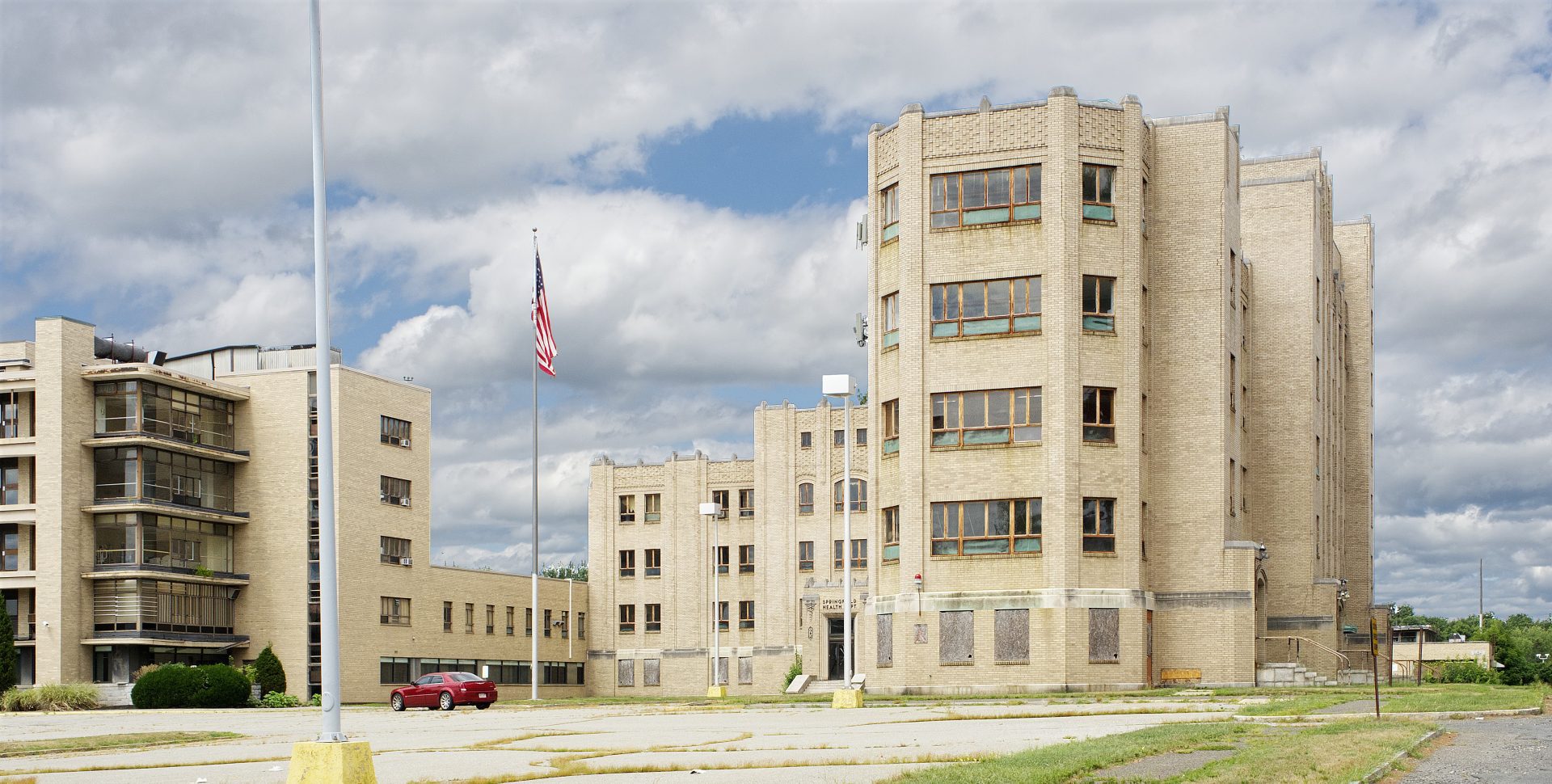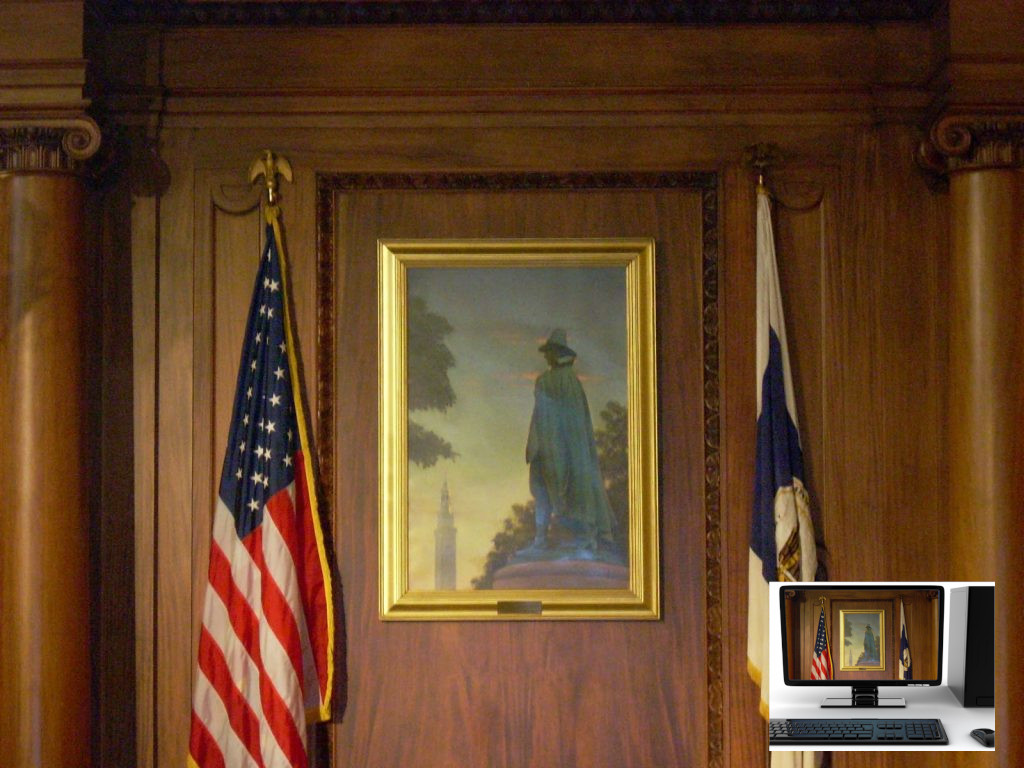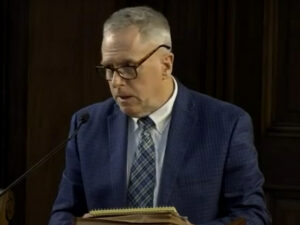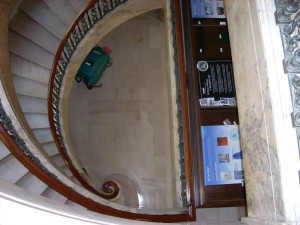Take My Council, Please: Standing in Historic Isolation…
UPDATED 5/5/23 1:10PM: To correct the vote on referring the historic district committee and to correct and clarify that the entire complex includes more than one parcel and only 1414 State Street’s parcel is in the proposed Isolation Hospital Historic District. An earlier version of this article misstated the vote and incorrectly stated that Councilor Hurst opposed referral to committee.
During an otherwise unremarkable meeting, the Springfield City Council paused final passage of a new historic district amid doubts and legal threats from the owner. At their April 10 meeting, councilors gave initial approval to historic protection for the former Isolation Hospital on State Street. By the time the meeting on May 1 began, the owner was rattling the legal sabers.
Aside from a new pact with the International Association of Firefighters, Local 648, the meeting featured few standout items. Whether an absence of controversy or more efficient process—and fewer leftover items due to slow-moving fully remote meetings—the Council has been speeding through its agendas lately.
After a brief technical hiccup, the meeting commenced with Councilors Victor Davila, Malo Brown and Tracye Whitfield participating remotely. Councilors Zaida Govan and Maria Perez were absent.
As per usual, the meeting opened with reports of committee. Ward 7 Councilor Timothy Allen, Chair of the Finance Committee, described his panel’s favorable review of the Council’s financial items. Casino Oversight Chair and Ward 2 Councilor Michael Fenton related updates from MGM. Among them is long-anticipated revival of operations the pandemic had curtailed. Fenton also noted that MGM is bringing in big-name entertainment including Tina Fey and Bruno Mars.
The Council accepted an unremarkable March revenue and expenditure report. Comptroller Pat Burns said both were at about 75% for the year—appropriate for the ¾ mark of the fiscal year.
Utility reports received the greenlight. These included a light pole on Wilcox Street and gas line work on Wendell Place, White Street and Wilbraham Road. Councilors also approved an increase in a research grant. Among the participating entities are both hospitals in the city, Tapestry Health and Open Pantry. Councilors also approved an agreement with the state to accept speed-measuring equipment in school zones.
The firefighters’ labor contract was technically two agreements. The first was for one year beginning July 1, 2020. This included a 2.5% raise plus a 1% hazard pay raise (this would have been high-covid, after all). The second agreement runs from July 1, 2021 through June 30, 2024. It, too, includes 2.5% annual pay increases.
HR/labor relations director Bill Mahoney said the agreement includes technical changes to require firefighters to comply with residency ordinance paperwork. Firefighters had agreed to submit to the city’s residency ordinance in the last contract. However, now they must fill out the annual certification.
While the city can regulate its workforce, local employment rules, including the residency ordinance, are subject to collective bargaining under state law. The firefighters were among the last bargaining units to agree, but they—along with police—must only live in Springfield for 10 years after their hiring. In response a question from the Council, Mahoney said firefighters had to be residents on day one. They cannot avail themselves of the one-year grace period under the ordinance.
The labor contract and a $2.9 million appropriation to finance back pay passed without dissent.
Councilors passed a $201,000 transfer within the Parks & Recreation Department to pay for higher diesel fuel costs and vehicle repair. A similar transfer within the Fire budget in the amount of $65,000 financed higher fuel costs for the department’s trucks.
The body also authorized a $50,000 transfer from contingencies to pay UMass for administering Medicaid reimbursement. Springfield has an arrangement with UMass Medical Center in which the latter processes Medicaid claims for health services city schools perform. UMass receives 2.5% of the claims the city collects. Burns, the Comptroller, said the schools had collected more than officials originally expected. While positive, this also meant the city had to replenish the account that pays UMass.
The Council also approved payment of $3079 for prior year Police Department bills.
Although nobody from the Fire Department was available to speak on Monday, the Council granted final passage to a fire inspection ordinance. The bill would revise the power of the Fire Commission or the department’s fire prevention bureau to order upgrades when fire suppression systems are inadequate. Fire Commissioner B.J. Calvi had spoken on the items behalf on April 10.
Councilors granted final passage to an ordinance that creates a new revolving fund for health care for the homeless. They also adopted a resolution Ward 5 Councilor Lavar Click-Bruce introduced urging the NCAA Tip-off Classic to return to Springfield. At-large Councilor Kateri Walsh exited the Council well to address the body from the podium to urge passage.
Walsh explained, as several councilors also attested, how her late husband Daniel, a Providence College alum where he played basketball, had been instrumental in bringing the game to Springfield. Having that game in the birthplace of basketball was a point of particular pride.
The historic district around Isolation Hospital, however, hit a speed bump after the Law Department received a letter from the owner, Vibra Hospital. The organization all but threatened litigation if the district became law.

But can you isolate its historic features? (via springfieldpreservation.org)
The Springfield Preservation Trust spearheaded the designation amid concerns that the hospital building is at risk of demolition. The entire building is not historic. Newer portions, while connected, are on a separate parcel. However, the Art Deco wing dating to 1930 has attracted preservationists’ attention. The single parcel district would only cover this wing’s parcel at 1414 State Street. In addition to once being part of the former municipal hospital campus, it was once home of the city health department.
That wing has been vacant for many years. Although the district had not originated with the Springfield Historical Commission, that body had agreed to advance the designation to the full Council. Historic Districts exist in city ordinance, however state law governs them.
A representative of Vibra, Stephen Wagner, told councilors that his employer’s contract with the state to provide mental health service was ending soon. Vibra, therefore, was marketing the building. However, Wagner could not speak to the owner’s plans for the property beyond that.
Litigation alone would not necessarily cause the Council to back off a historical district. However, at the April 10 meeting, when first step on the district ordinance had passed, councilors, Brown, the relevant ward councilor, expressed concern that the property owner had not chimed in.
On Monday, councilors warned that the deteriorating 1930 building was in dire need of attention. Ward 3 Councilor Melvin Edwards called it “an eyesore.” The Council voted to put the item back into committee on a 8-2 vote. Councilor Davila and Jesse Lederman dissented. Councilor Whitfield abstained.
There is some disagreement about the historic value of Isolation Hospital. Other historic organs in the city, including the Historical Commission, did not seem enthusiastic. However, others touted it as the city’s largest Art Deco building. The disagreement may truly lie in how the newer wings have little or no historic value.
However, a historic district is erected around the whole parcel, in this case encompassing the 1930 Art Deco Isolation Hospital and moats of parking. How to maintain the structure while allow other uses for the rest of the parcel is the tricky part. While the owners may prefer no district at all, perhaps some accommodation can protect the 1930 structure but leave the remainder of the parcel to the whims of fate and progress.


